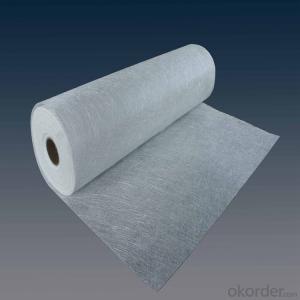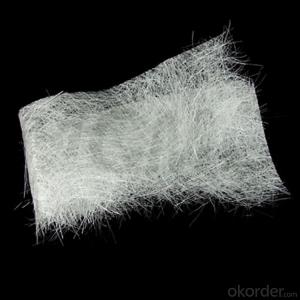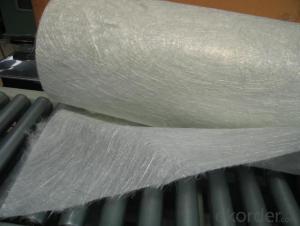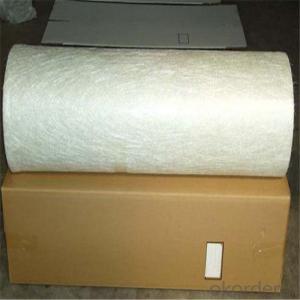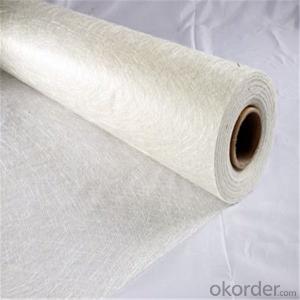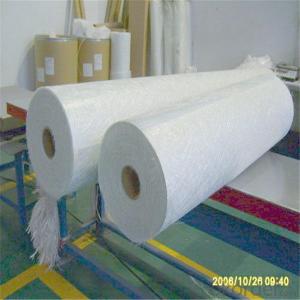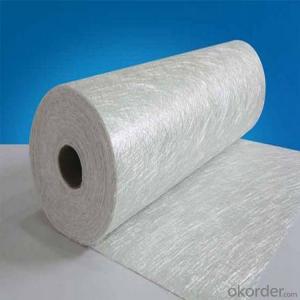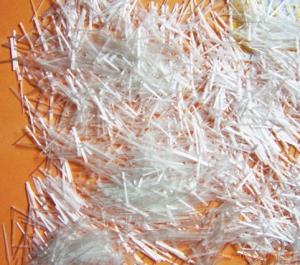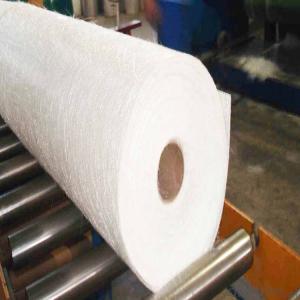CSM Glass Fiber Chopped Strand Mat/Fiberglass Mat/Emulsion or Powder Mat
- Loading Port:
- China main port
- Payment Terms:
- TT OR LC
- Min Order Qty:
- 50 kg
- Supply Capability:
- 10000 kg/month
OKorder Service Pledge
OKorder Financial Service
You Might Also Like
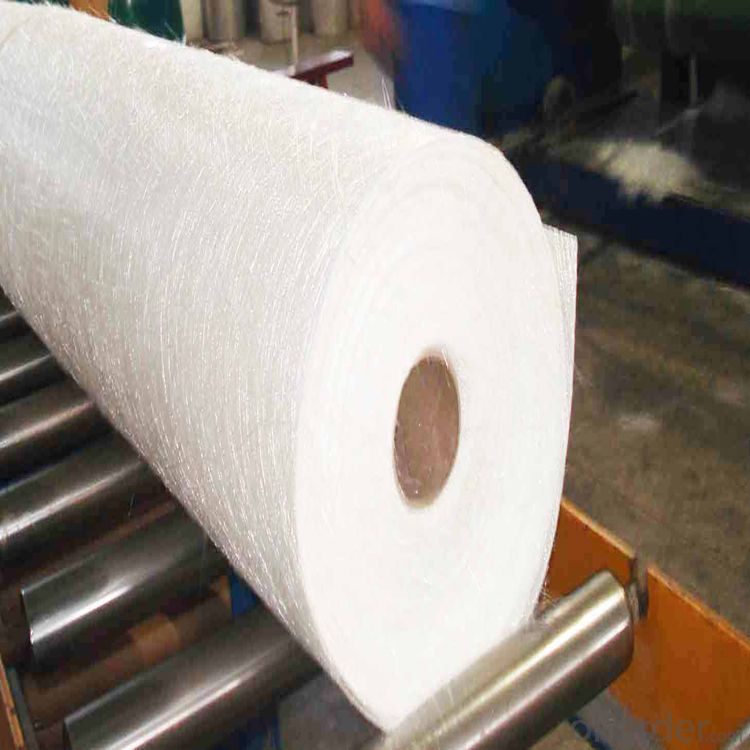
Product Description:
Fiberglass Chopped Strand Mat is fine strand reinforcement material made from E-glass cut fibers laid in a random pattern and bonded with powder or emulsion binder.
It is easy to handle and has excellent moulding performance.
Also, it has rapid resin penetration together with a fast strand wet out time.
The mat also brings a highly translucent finished laminates.
Also,the fine strand input makes the fiber prominence at the finished laminates surface extremely low.
Features
1.Excellent weight uniformity
2.Fast wet out
3.Easy air release
4.Excellent transparency of finished products
5.Excellent laminate
6.Low resin consumption
Application
1.Translucent roof panel
2.chemical storage tanks
3.FRP pipes
4.Boat hulls
5.Decks
6.Truck body panel
7.Cooling towers
8.Corrosion resistand
Specifications:
Item | Over Density | Moisture Content | Chop Density | Polyester Yarn | Width |
(g/m2) | (%) | (g/m2) | (g/m2) | (mm) | |
EMK300 | 309.5 | ≤0.15 | 300 | 9.5 | 50-3300 |
EMK380 | 399 | 380 | 19 | ||
EMK450 | 459.5 | 450 | 9.5 | ||
EMK450 | 469 | 450 | 19 | ||
EMC0020 | 620.9 | 601.9 | 19 | ||
EMC0030 | 909.5 | 900 | 9.5 |
Special products are available according to customer’s requirement.
Product Packaging:
Each Surface Tissue is wound onto a paper tube which has an inside diameter of 76mm and the mat roll has a diameter of 330mm. The mat roll is wrapped up with plastic film,and then packed in a cardboard box or wrapped up with kraft paper. The rolls can be vertically or horizontally placed. For transportation, the rolls can be loaded into a cantainer directly or on pallets.
Quantity
20'GP Container:About 10000kgs
40'HP Container:Aboout 23100kgs
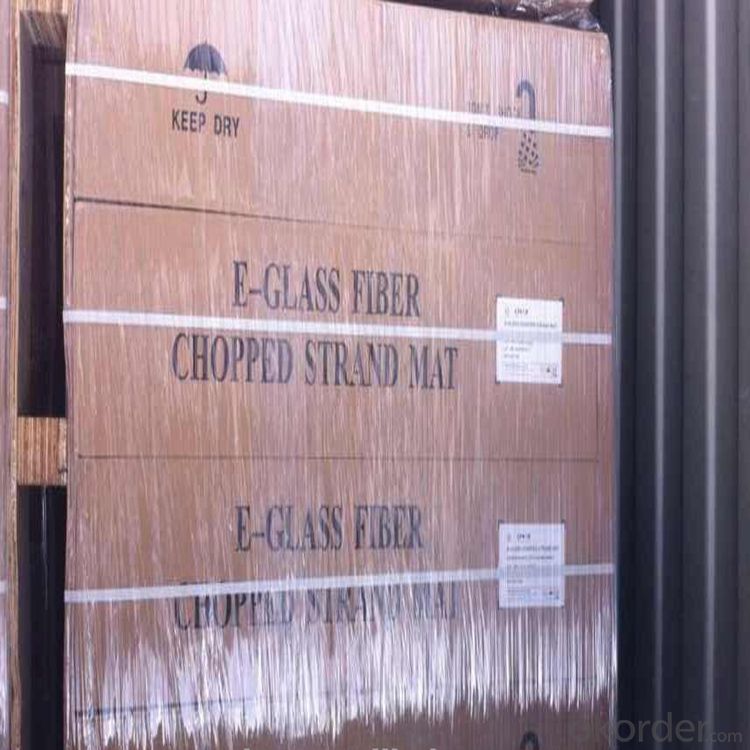
Product Storage:
Unless otherwise specified, Chopped Strand Mat should be stored in a dry, cool and rain-proof area. It is recommended that the room temperature and humidity should be always maintained at 15℃~35℃ and 50%~75% respectively.
Company Information
CNBM (China National Building Material) Group is the largest comprehensive building materials group in China that in integrate scientific research, manufacturing and logistics into one entity. The largest building materials and equipment specialists in China. Upon State Council approval, today CNBM owned more than 300 subordinate manufacturing factories and servicing companies. There are 6 fully owned public listed companies and 11 partially owned with substantial shares public listed companies. In many of these fields, CNBM is playing the leading role in the building industry in the country.

Our Service:
1.Any inquiry will be replied within 24 hours.
2.Professional manufacturer.
1) Print logo in the products;
2) The size and specification can be produce and design according to your demand.
3.High quality,fashion designs,reasonable and competitive price,fast lead time.
4.After-sale service
1) All products will have been strictly quality check in house before packing.
2) All products will be well packed before shipping.
3) All our products have 10 years rot resistance.
5.Faster delivery:sample order in stock,and 15-20 days for bulk production.
6.Payment:you can pay for the order via:T/T,Western Union,MoneyGram,L/C etc.
FAQ:
which kind of glass fiber sample and materials can you provide?
We can provide the glass fiber and glass fiber down stream products samples of E glass, C glass, ECR glass, High alkali glass. The products includes single end roving, assembled roving for different applications( Piping, SMC, panel, winding mill plate) , chop strand for BMC, engineering plastic (PA, PPA, PPT, POM, etc), chop strand mat (from 100gsm-900gsm) for automobile and water tank, etc, woven roving (270gsm-800gsm), surface tissue (25-50gsm), multi-axial fabric of different unit weight.
- Q:Is fiberglass chopped strand suitable for automotive body parts?
- Yes, fiberglass chopped strand is suitable for automotive body parts. Fiberglass is a lightweight and strong material that offers excellent durability and impact resistance, making it ideal for automotive applications. Chopped strand mat, made of randomly oriented strands, provides reinforcement to the body parts, enhancing their strength and stiffness. Additionally, fiberglass is corrosion-resistant and can withstand harsh environmental conditions, making it a reliable choice for automotive body parts. Its versatility allows it to be easily molded and shaped into complex designs, providing flexibility for automotive manufacturers. Overall, fiberglass chopped strand is a suitable material for automotive body parts due to its strength, durability, and versatility.
- Q:What are the typical sustainability considerations when using fiberglass chopped strand composites?
- When using fiberglass chopped strand composites, there are several typical sustainability considerations that should be taken into account. Firstly, the production of fiberglass involves the extraction of silica sand, which is a non-renewable resource. It is important to consider the environmental impact of mining and processing silica sand, as well as the potential for habitat destruction and water pollution. Another sustainability consideration is the energy consumption associated with the manufacturing process of fiberglass composites. The production of fiberglass requires high temperatures for melting and shaping the material, which results in significant energy usage. This energy consumption contributes to greenhouse gas emissions and climate change. Furthermore, the disposal of fiberglass chopped strand composites can be challenging from a sustainability perspective. Fiberglass is not biodegradable and can persist in the environment for a long time. Proper disposal methods, such as recycling or finding alternative uses for the material, should be considered to minimize waste and environmental impact. Additionally, the health and safety of workers during the manufacturing process of fiberglass chopped strand composites should be taken into account. The production and handling of fiberglass can release harmful fibers and chemicals into the air, which can pose health risks to workers if not properly controlled. Implementing appropriate safety measures and ensuring worker protection is crucial for sustainability in this context. To address these sustainability considerations, various initiatives and technologies are being developed. These include the use of recycled fiberglass, the development of more energy-efficient manufacturing processes, and the implementation of stricter regulations and guidelines to ensure the safe production and disposal of fiberglass chopped strand composites. Overall, to achieve sustainability when using fiberglass chopped strand composites, it is important to consider the environmental impact of the raw materials, energy consumption during production, disposal practices, and worker safety. By addressing these considerations, the use of fiberglass composites can be made more sustainable and environmentally friendly.
- Q:Is fiberglass chopped strand compatible with vinyl ester resin?
- Yes, fiberglass chopped strand is compatible with vinyl ester resin.
- Q:What are the typical manufacturing processes for fiberglass chopped strand composites?
- The manufacturing of fiberglass chopped strand composites involves a series of essential steps. To begin with, the raw materials, which consist of chopped fiberglass strands and a resin matrix, are readied. The chopped fiberglass strands are typically made by cutting continuous glass fibers into shorter lengths, usually ranging from 0.5 to 3 inches. Following this, the resin matrix, typically a thermosetting material like polyester, vinyl ester, or epoxy, is mixed with various additives and catalysts to improve its mechanical properties and curing characteristics. The ratio of resin to chopped fiberglass strands is determined based on the desired strength and performance of the final composite. After the preparation of the raw materials, they are combined through a process known as impregnation. This involves thoroughly coating the chopped fiberglass strands with the resin matrix to ensure saturation. Various techniques, such as hand lay-up, spray-up, or filament winding, can be employed to achieve this. Once impregnation is complete, the composite material is shaped according to the desired form. This can be accomplished using techniques like compression molding, injection molding, or pultrusion. Compression molding requires placing the impregnated material into a mold and applying heat and pressure to shape and cure the resin. Injection molding follows a similar process but entails injecting the resin into a closed mold under high pressure. Pultrusion, on the other hand, continuously pulls the impregnated material through a heated die to shape it into a continuous profile. After shaping, the composite is cured to ensure the hardening of the resin matrix and bonding of the chopped fiberglass strands. Curing can be achieved through heat, chemical reactions, or a combination of both, depending on the specific resin system used. The temperature and duration of curing are precisely controlled to attain the desired mechanical properties and dimensional stability. Lastly, the cured composite undergoes trimming, finishing, and quality inspection. Trimming involves the removal of any excess material or flash that may have formed during shaping and curing. Additional post-processing steps, such as sanding, painting, or coating, may be applied to further enhance the appearance and performance of the finished composite. In summary, the manufacturing processes for fiberglass chopped strand composites involve the preparation of raw materials, impregnation of the chopped fiberglass strands, shaping of the composite, curing of the resin, and finishing of the final product. These processes can be customized based on specific application requirements and desired composite properties.
- Q:How does the creep resistance of the chopped strand affect its performance?
- The creep resistance of chopped strand is a critical factor that directly affects its performance. Creep is the tendency of a material to gradually deform under constant load over time. In the case of chopped strand, creep resistance refers to its ability to resist this deformation and maintain its shape and structural integrity. A high creep resistance in chopped strand is desirable because it ensures the material will not undergo excessive deformation or failure when subjected to long-term or sustained loads. This is particularly important in applications where the chopped strand is used as reinforcement in composites or structural components. When a material has poor creep resistance, it can experience significant dimensional changes, such as elongation or shrinkage, over time. This can lead to a loss of strength, stiffness, and overall performance of the chopped strand and the final product it is incorporated into. On the other hand, chopped strand with good creep resistance will maintain its shape and dimensions even under prolonged stress, ensuring the structural integrity and longevity of the composite or component. It will also provide better load-bearing capabilities and resistance to fatigue or failure caused by repetitive or cyclic loading. To summarize, the creep resistance of chopped strand is crucial for its performance as it directly influences the material's ability to resist deformation and maintain structural integrity under sustained loads. By choosing chopped strand with high creep resistance, manufacturers can ensure the durability, reliability, and long-term performance of their products.
- Q:How is the quality of fiberglass chopped strand ensured during production?
- The quality of fiberglass chopped strand is ensured during production through various measures. Firstly, the raw materials used in the production are carefully selected to meet specific requirements and standards. The production process itself involves strict control over parameters such as temperature, pressure, and resin distribution to ensure uniformity and consistency in the final product. Additionally, regular inspections and testing are conducted throughout the production process to identify any defects or deviations from the desired quality. These quality control measures help ensure that the fiberglass chopped strand meets the required specifications and delivers optimal performance in its intended applications.
- Q:Can fiberglass chopped strand be used in water treatment tanks?
- Yes, fiberglass chopped strand can be used in water treatment tanks. Fiberglass is known for its excellent corrosion resistance and high strength-to-weight ratio, making it a suitable material for various applications in the water treatment industry. The chopped strand form of fiberglass can be used to reinforce the tanks, making them more durable and resistant to wear and tear. Additionally, fiberglass is non-reactive to water and does not leach any harmful substances, which is crucial for maintaining water quality in treatment tanks. Overall, fiberglass chopped strand is a reliable and effective material for use in water treatment tanks.
- Q:Is fiberglass chopped strand compatible with unsaturated polyester resin?
- Yes, fiberglass chopped strand is compatible with unsaturated polyester resin. Fiberglass chopped strand is commonly used as reinforcement in composite materials, and unsaturated polyester resin is a common matrix material for composites. When mixed together, the chopped strand provides strength and reinforcement to the resin, resulting in a strong and durable composite material. The compatibility between fiberglass chopped strand and unsaturated polyester resin ensures good adhesion and bonding between the two materials, allowing for efficient manufacturing and reliable performance of composite products.
- Q:What are the different lengths available for fiberglass chopped strand?
- Various lengths of fiberglass chopped strand are available to meet different needs and applications. The most common lengths range from 1/8 inch (3.2 mm) to 2 inches (50.8 mm). However, manufacturers may also offer shorter lengths, like 1/16 inch (1.6 mm), or longer lengths exceeding 2 inches (50.8 mm), depending on specific requirements. Choosing the appropriate length depends on factors such as desired strength, thickness, and flexibility of the end product. Shorter lengths are often preferred for applications that require improved surface finish and dimensional stability, like panel and sheet molding compounds. On the other hand, longer lengths are typically used in applications that require increased strength and reinforcement, such as fiberglass-reinforced plastics or composite materials. It is important to consider that the length of the fiberglass chopped strand significantly affects the performance and characteristics of the final product. Therefore, it is advisable to consult the manufacturer or supplier to determine the most suitable length for your specific application.
- Q:What types of resins can be used with fiberglass chopped strand?
- There are several types of resins that can be used with fiberglass chopped strand. The most commonly used resins include polyester resin, epoxy resin, and vinyl ester resin. Polyester resin is the most widely used resin for fiberglass applications due to its low cost and ease of use. It is suitable for a variety of applications including boats, automotive parts, and construction materials. Epoxy resin is known for its superior strength and excellent adhesion to various substrates, making it ideal for high-performance applications such as aerospace and marine industries. Vinyl ester resin is a hybrid between polyester and epoxy resins, offering improved corrosion resistance and toughness. It is often used in applications that require enhanced durability and chemical resistance, such as chemical storage tanks and pipes. Ultimately, the choice of resin depends on the specific requirements of the application, such as strength, durability, and chemical resistance.
1. Manufacturer Overview |
|
|---|---|
| Location | |
| Year Established | |
| Annual Output Value | |
| Main Markets | |
| Company Certifications | |
2. Manufacturer Certificates |
|
|---|---|
| a) Certification Name | |
| Range | |
| Reference | |
| Validity Period | |
3. Manufacturer Capability |
|
|---|---|
| a)Trade Capacity | |
| Nearest Port | |
| Export Percentage | |
| No.of Employees in Trade Department | |
| Language Spoken: | |
| b)Factory Information | |
| Factory Size: | |
| No. of Production Lines | |
| Contract Manufacturing | |
| Product Price Range | |
Send your message to us
CSM Glass Fiber Chopped Strand Mat/Fiberglass Mat/Emulsion or Powder Mat
- Loading Port:
- China main port
- Payment Terms:
- TT OR LC
- Min Order Qty:
- 50 kg
- Supply Capability:
- 10000 kg/month
OKorder Service Pledge
OKorder Financial Service
Similar products
New products
Hot products
Hot Searches
Related keywords
